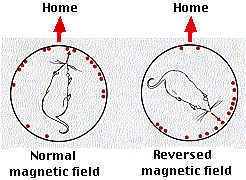| Left: orientation taken by individual woodmice after being removed from their home in a closed box. Right: same experiment except that the mice were subjected to a reversed magnetic field as they were moved from their home. Each dot represents the orientation taken by one mouse. The arrow within each circle indicates the average for all the mice. Mice transported in an open box so they can see landmarks orient correctly whether or not they are exposed to an abnormal magnetic field. (Based on the work of Mather and Baker, Nature, 291:152, 1981.) |  |
Fransson and colleagues report in the 1 November 2001 issue of Nature that when they confined naive birds (born in Sweden that spring) in Sweden but exposed them to a magnetic field characteristic of northern Egypt, the birds proceeded to put on weight as though they had arrived in Egypt (and three times more than control birds kept in the normal magnetic field of Sweden).